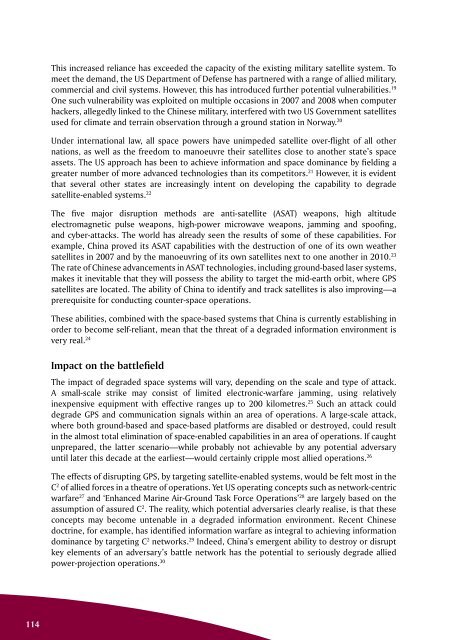190%202013%20Mar_Apr
190%202013%20Mar_Apr
190%202013%20Mar_Apr
You also want an ePaper? Increase the reach of your titles
YUMPU automatically turns print PDFs into web optimized ePapers that Google loves.
114<br />
This increased reliance has exceeded the capacity of the existing military satellite system. To<br />
meet the demand, the US Department of Defense has partnered with a range of allied military,<br />
commercial and civil systems. However, this has introduced further potential vulnerabilities. 19<br />
One such vulnerability was exploited on multiple occasions in 2007 and 2008 when computer<br />
hackers, allegedly linked to the Chinese military, interfered with two US Government satellites<br />
used for climate and terrain observation through a ground station in Norway. 20<br />
Under international law, all space powers have unimpeded satellite over-flight of all other<br />
nations, as well as the freedom to manoeuvre their satellites close to another state’s space<br />
assets. The US approach has been to achieve information and space dominance by fielding a<br />
greater number of more advanced technologies than its competitors. 21 However, it is evident<br />
that several other states are increasingly intent on developing the capability to degrade<br />
satellite-enabled systems. 22<br />
The five major disruption methods are anti-satellite (ASAT) weapons, high altitude<br />
electromagnetic pulse weapons, high-power microwave weapons, jamming and spoofing,<br />
and cyber-attacks. The world has already seen the results of some of these capabilities. For<br />
example, China proved its ASAT capabilities with the destruction of one of its own weather<br />
satellites in 2007 and by the manoeuvring of its own satellites next to one another in 2010. 23<br />
The rate of Chinese advancements in ASAT technologies, including ground-based laser systems,<br />
makes it inevitable that they will possess the ability to target the mid-earth orbit, where GPS<br />
satellites are located. The ability of China to identify and track satellites is also improving—a<br />
prerequisite for conducting counter-space operations.<br />
These abilities, combined with the space-based systems that China is currently establishing in<br />
order to become self-reliant, mean that the threat of a degraded information environment is<br />
very real. 24<br />
Impact on the battlefield<br />
The impact of degraded space systems will vary, depending on the scale and type of attack.<br />
A small-scale strike may consist of limited electronic-warfare jamming, using relatively<br />
inexpensive equipment with effective ranges up to 200 kilometres. 25 Such an attack could<br />
degrade GPS and communication signals within an area of operations. A large-scale attack,<br />
where both ground-based and space-based platforms are disabled or destroyed, could result<br />
in the almost total elimination of space-enabled capabilities in an area of operations. If caught<br />
unprepared, the latter scenario—while probably not achievable by any potential adversary<br />
until later this decade at the earliest—would certainly cripple most allied operations. 26<br />
The effects of disrupting GPS, by targeting satellite-enabled systems, would be felt most in the<br />
C 2 of allied forces in a theatre of operations. Yet US operating concepts such as network-centric<br />
warfare 27 and ‘Enhanced Marine Air-Ground Task Force Operations’ 28 are largely based on the<br />
assumption of assured C 2 . The reality, which potential adversaries clearly realise, is that these<br />
concepts may become untenable in a degraded information environment. Recent Chinese<br />
doctrine, for example, has identified information warfare as integral to achieving information<br />
dominance by targeting C 2 networks. 29 Indeed, China’s emergent ability to destroy or disrupt<br />
key elements of an adversary’s battle network has the potential to seriously degrade allied<br />
power-projection operations. 30


